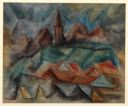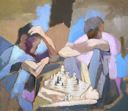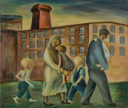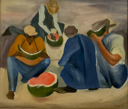Crawford Gillis
American
(Dallas County, Alabama, 1914 - 2000)
While Alabama painters such as Kelly Fitzpatrick focused on the beauty of the Southern landscape, younger artists such as Crawford Gillis and his contemporary Charles Shannon portrayed the people of Alabama during the height of the Great Depression, capturing the desperation and futility that characterized the life of the common man. Theirs was a landscape of grinding poverty and often despair. Gillis lived in Selma, an Alabama community with a storied heritage located about fifty miles west of Montgomery. Once a key settlement of Alabama’s Black Belt (the geographic center of the state’s cotton cultivation), Selma later became a focus of national attention during the Civil Rights Movement of the 1960s. West Alabama was one of the state’s poorest regions, and Gillis sought to capture the life of the community as he knew it. As he once told an interviewer, “I was the proletariat.” (1) Gillis was born in Dallas County, just outside of Selma. He took art classes locally before going to New York City in 1935 with his friend, fellow Selma painter John Lapsley, to study at the National Academy of Design. At the academy, Gillis studied with Leon Kroll and Charles Courtney Curran. “We got bored there,” he later wrote, “It was routine…. We spent most of our time checking galleries in New York.” (2) In January 1938, Gillis earned critical praise for an exhibition, held at New York’s Delphic Studios, of paintings he had made in Alabama. Upon his return to the state in 1939, he joined Shannon, Lapsley, and others as part of the New South School and Art Gallery, an association of young artists and writers who sought to improve the cultural environment in Montgomery. In the New South’s downtown quarters, Gillis taught classes in composition and had an exhibition of his works in November 1939. In 1941 he was drafted and served in the Coast Artillery and with combat engineers overseas until 1945. When he returned to Alabama, he was employed in the civil service at Craig Airfield and continued painting in his spare time.
(1) William U. Eiland, “Picturing the Unvictorious: The Southern Scene in Alabama, 1930–1946,” in The American Scene and the South: Paintings and Works on Paper, 1930–1946, ed. Patricia Phagan (Athens, GA: Georgia Museum of Art, 1996), p. 65.
(2) Miriam Fowler, New South, New Deal, and Beyond (Montgomery: The Alabama State Council on the Arts, 1989), p. 7.
American
(Dallas County, Alabama, 1914 - 2000)
While Alabama painters such as Kelly Fitzpatrick focused on the beauty of the Southern landscape, younger artists such as Crawford Gillis and his contemporary Charles Shannon portrayed the people of Alabama during the height of the Great Depression, capturing the desperation and futility that characterized the life of the common man. Theirs was a landscape of grinding poverty and often despair. Gillis lived in Selma, an Alabama community with a storied heritage located about fifty miles west of Montgomery. Once a key settlement of Alabama’s Black Belt (the geographic center of the state’s cotton cultivation), Selma later became a focus of national attention during the Civil Rights Movement of the 1960s. West Alabama was one of the state’s poorest regions, and Gillis sought to capture the life of the community as he knew it. As he once told an interviewer, “I was the proletariat.” (1) Gillis was born in Dallas County, just outside of Selma. He took art classes locally before going to New York City in 1935 with his friend, fellow Selma painter John Lapsley, to study at the National Academy of Design. At the academy, Gillis studied with Leon Kroll and Charles Courtney Curran. “We got bored there,” he later wrote, “It was routine…. We spent most of our time checking galleries in New York.” (2) In January 1938, Gillis earned critical praise for an exhibition, held at New York’s Delphic Studios, of paintings he had made in Alabama. Upon his return to the state in 1939, he joined Shannon, Lapsley, and others as part of the New South School and Art Gallery, an association of young artists and writers who sought to improve the cultural environment in Montgomery. In the New South’s downtown quarters, Gillis taught classes in composition and had an exhibition of his works in November 1939. In 1941 he was drafted and served in the Coast Artillery and with combat engineers overseas until 1945. When he returned to Alabama, he was employed in the civil service at Craig Airfield and continued painting in his spare time.
(1) William U. Eiland, “Picturing the Unvictorious: The Southern Scene in Alabama, 1930–1946,” in The American Scene and the South: Paintings and Works on Paper, 1930–1946, ed. Patricia Phagan (Athens, GA: Georgia Museum of Art, 1996), p. 65.
(2) Miriam Fowler, New South, New Deal, and Beyond (Montgomery: The Alabama State Council on the Arts, 1989), p. 7.
Artist Objects









